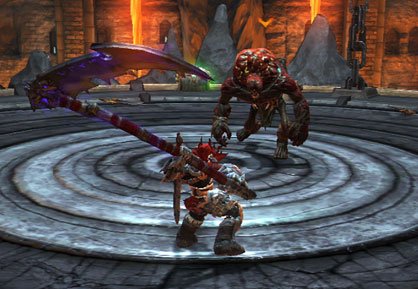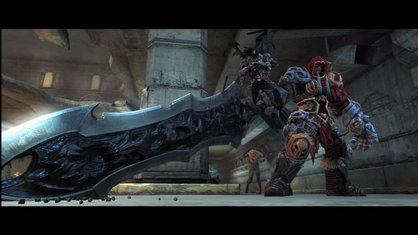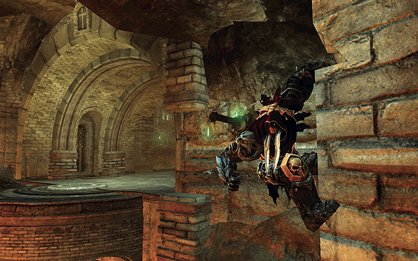Why you can trust GamesRadar+
Also, it’s not as if Darksiders doesn’t sport a few gameplay innovations of its own. Probably its most notable one is its approach to the secondary weapons War finds over the course of the game: a giant purple scythe and a big, enemy-smashing gauntlet. In a God of War or Devil May Cry, you’d generally use these to replace the hero’s default weapon, at which point you’d realize that they’re simply not as much fun to wield. In Darksiders, meanwhile, they actually supplement War’s hulking sword, meaning that you can switch instantly between them to chain together lengthy, multi-weapon combos.

That’s not even counting the random environmental objects you can grab and use as clubs, the wrecked cars you can pick up and throw, or the bulky angelic/demonic heavy firearms that can temporarily make you damn-near invincible.Add in War’s tertiary weapons – which eventually include a pistol, a shuriken-like boomerang and a horn that can stun enemies – and the combat can get pretty ridiculous.
Of course, that’s only if you actually remember to use all that stuff in the heat of combat, along with all the combos and special moves you can unlock. If you’re more the type to mash buttons randomly and hope for the best, you’re likely to find the action pretty damn repetitive.

Actually, you might find it repetitive even if you can remember the slew of attacks at your disposal, thanks to the tiny number of fatalities you can perform on the demons you’ll meet. See, really there are only a handful of basic enemy types in the game, with different creature skins used to denote levels of toughness and to create the illusion of variety. No matter what skin they’re wearing, however, each enemy type only has one or two finishing animations you can perform once you’ve beaten them down enough. Hours into the game’s 15-to-20-hour runtime, this gets awfully tedious; the fatalities are useful for ending fights quickly, but once you’ve chopped the legs off a hundred identical demon grunts and then dramatically slow-motion-sliced them in half in midair, the thrill is gone.

That’s also to say nothing of the irksome fetch-quests and schlep-quests the game occasionally puts you through; these don’t happen often, but when they do, get ready for a lot of tedious backtracking across the map. The worst ones happen near the beginning; you’ll meet a couple of sentient gates who simply can’t move until you remove the curse than binds them. To do that, you’ll need to find your way to several hidden portals scattered around nearby, enter each one separately, and then fight waves of enemies in tedious arena fights with very specific victory conditions. It feels like an enormous waste of time, but thankfully you’ll only need to remove two of these curses.
At this point, you may be wondering how much appeal there really is in wandering around a dead world, hacking whatever you meet to death in grisly ways. The answer is quite a lot, really; far from being a bleak reminder of a dead civilization, the world War inhabits is a twisted fantasy version of New York, reshaped by a century of demonic occupation into a visually arresting, platform-and-puzzle-filled world that’s a blast to explore (and not just because it’s filled with cool secrets and hidden junk to collect).

Unsurprisingly for a game that takes so many cues from Zelda, the best parts of the game are its dungeons – vast, puzzle-filled complexes that include a decaying cathedral and a flooded subway station, among other fascinating ruins. The most important puzzles in each (as well as the dungeon-ending boss fights) are based around a single tool or weapon that lies hidden somewhere inside, and once you’ve found it, it’s like the whole place (as well as previously inaccessible areas elsewhere on the map) suddenly opens up to you. Again, if you’ve ever played through a recent Zelda (or even Metroid) game, you already know the feeling.
More info
| Genre | Action |
| Description | In spite of lifting nearly every gameplay element from other, often better games, Darksiders still succeeds at bringing these disparate threads together into a brutally satisfying whole. It's also a blast to explore even at its low points, and if the idea of a Zelda with a more mature bent and better combat catches your interest, you'll want to check this out. |
| Platform | "PC","PS3","Xbox 360" |
| US censor rating | "Mature","Mature","Mature" |
| UK censor rating | "18+","18+","18+" |
| Alternative names | "Darksiders: Wrath of War" |
| Release date | 1 January 1970 (US), 1 January 1970 (UK) |




